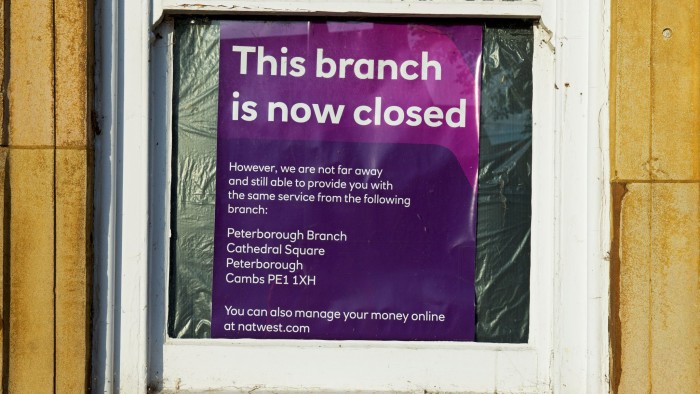Banks are an endangered species on our high streets


Roula Khalaf, Editor of the FT, selects her favourite stories in this weekly newsletter.
Bank branches are an endangered species on our high streets. There are already 3,000 communities in Britain that no longer have a single bank — mostly market towns and in the countryside — says the Post Office.
Before the slew of closures announced last week, branch numbers had fallen 10 per cent this year, according to the Local Data Company, which says bank closures are going “further and faster”.
Banks explain the trend by pointing to the growing popularity of online services, the falling number of customer visits and the cost of maintaining a branch network. You can see the same trend at work in the retail sector. Online shopping means store numbers are being sliced, with “destination” shops clustered in more populous and affluent areas.
Our vanishing bank network causes serious worry for FT Money readers. It’s not just older people who rely on banking in branch rather than online. There are millions of digitally disenfranchised consumers who rely on cash because they do not have smartphones or a home broadband connection. I also hear from many readers who do not want to try any form of online banking.
Two of them are Mr and Mrs Barrett — my parents. They are in their late 70s and computer literate. But they worry, perhaps unjustly, that banking online will make them more vulnerable to fraud. They don’t even like paying for items online with a credit card. I indulge them and book their holidays, travel tickets and order their online shopping — and they post me a cheque.
Soon I will be able to pay in their cheques by taking a photo on my bank’s app. If I wanted to visit a bank branch, I am well provided for in London.
“Where there’s brass, there’s banks. Where there isn’t, there ain’t,” is the snappy up-sum from Matthew Hopkinson of the Local Data Company.
His research shows the affluent south is far better provided for. At the last count there were more than 1,100 bank branches in Greater London — compared with 743 in the whole of Scotland. There has been an average closure rate of 10 per cent across the UK this year but in Scotland it is 16 per cent and in London it is 7 per cent.
According to LDC’s year-on-year comparison, the number of Clydesdale Bank branches has fallen by 39 per cent, Yorkshire Bank by 29 per cent, NatWest by 20 per cent, HSBC by 16 per cent, Lloyds by 13 per cent and Bank of Scotland by 12 per cent. Metro Bank’s branch network has expanded by 8 per cent — it now has 55, the farthest north being Peterborough.
Clearly there is a problem. The obvious response is legislation. A few years ago, politicians tried and failed to get the big banks to sign up to a “last bank in town” pledge. Once a town or village has lost its only bank, the rest of the high street could enter terminal decline. People will travel to the next town and spend the money they withdraw in the shops there.
Once the banks go, so do their free cash points. This has been the focus of a separate political row this week. As banks shut shop, most of the UK’s cash points are operated by independent owners who are paid an “interchange fee” when a bank customer withdraws cash. Link, which oversees a network of free-to-use cash points, wants to cut these fees. There are fears that this could lead to fewer free cash points — yet more evidence of the cashless society conspiracy.
The solution the banks and the politicians are standing behind is the Post Office. The last bastion of cash on the high street, almost any customer of any bank (personal or business) can pay in cash or cheques, take money out or obtain change — with no charge to the customer. For bigger and more profitable services, such as mortgages, loans and investments, they will still need to travel to their bank’s “destination” branch.
About 95 per cent of the population lives within a mile of a Post Office. There are 11,600 branches across the country — more than all of the banks put together — and this number has held steady since 2009 while bank numbers have plummeted.
The Post Office will pass on a small transaction charge to your bank. With 120m transactions a year, it is clearly cheaper for the banks to fund this levy than keep their branches open. The number of transactions has grown by a tenth this year — the same rate at which bank branches are closing.
But think of a Post Office, and you will think of one thing — queues. How much more of the strain can the network take?
According to banking director Martin Kearsley, chip and pin technology has largely replaced paper-based transactions, freeing capacity to handle twice the current number of daily transactions. At the present rate of bank closures and transaction growth, that could take seven years. If the rate increases, though, it could take four to five.
Small business banking deposits are the biggest area of growth. Could politicians force the banks to pay a higher fee so Post Offices can upgrade, provide more staff and extend opening hours?
And what about changing business rates? Currently, charity shops are largely exempt from these charges. Why not extend the discount to the “last bank in town”? Giving any bank a tax break will be controversial but councils and business may see it as an investment.
Finally — and most controversially — what about customers? Just as we would expect to pay a fee for using an overdraft, would those customers who could afford it be prepared to pay a small annual charge to guarantee that their local branch would be spared from closure for a set period?
None of these solutions is perfect — but we want to get people talking. Tell us what you think. We promise to put your views to a panel of banking industry representatives in FT Money next year.
Claer Barrett is the editor of FT Money; claer.barrett@ft.com; Twitter: @Claerb
Comments